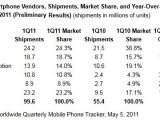The global smartphoner market went up 79.7 percent on a yearly basis during the first quarter of the ongoing year, the latest data from the International Data Corporation (IDC) Worldwide Quarterly Mobile Phone Tracker shows.
The market is growing due to older smartphones being offered at lower price tags, the availability of new, highly anticipated models, and increasing user demand.
According to IDC, smartphone vendors managed to ship a total of 99.6 million smartphone units in the first quarter of the year, which would be almost double than the 55.4 million units in the first quarter of 2010.
“Conditions in the smartphone market are creating a perfect storm for sustained smartphone growth,” says Ramon Llamas, senior research analyst with IDC's Mobile Phone Technology and Trends team.
“First, vendors are increasingly emphasizing smartphones as the key to their own growth. Second, selection has proliferated from mostly high-end devices to include more mid-range and entry-level offerings.
“Third, pricing has become increasingly competitive, with even high-end devices available at low price points. Finally, users continue to seek greater utility from their mobile phone beyond voice, and smartphones have been the ideal solution.”
Although it is moving from Symbian to Windows Phone, Nokia remains the market leader, with 24.2 million smartphones shipped in Q1, up from 21.5 shipped last year. Symbian still enjoys high demand, and the company already released new smartphones running under it.
“Still, as Nokia transitions from Symbian to Windows Phone, it may find itself in danger of ceding market share as the competition ramps up smartphone production,” IDC notes.
Apple ended the quarter on the second position, with 18.7 million smartphones, posting new record shipment volume for the time frame, helped by the availability of CDMA-enabled iPhone 4 and the release of the device in China.
RIM retained its third position on the podium, due to increased presence on the market in North America, but also outside of it. The company brought 3G devices to more markets, but its shipments included mainly older, lower-cost devices.
Samsung registered the highest year-over-year gain, which an increasing portfolio of smartphones, and their availability in various markets around the world. The company shipped 10.8 million smartphones in the time frame, up from only 2.4 a year ago.
“Accounting for the majority of its smartphones and driving shipment volumes higher was the continued success of its Android-based smartphones, including the high-end Galaxy S devices and mass-market Galaxy Ace and Galaxy mini devices,” IDC notes.
HTC ended the quarter on the fifth place on the smartphone market, with record shipment volume too, almost reaching the ten million unit mark for the first time.
The company announced the release of a wide range of new devices, including WiMAX-enabled EVO Shift 4G, and LTE-enabled Thunderbolt, as well as the Inspire 4G, or the Facebook-optimized Salsa and ChaCha.
The demand for smartphones is increasing, which means that the market would remain competitive, the research firm notes.
“The rise of Android as a prominent mobile operating system has allowed several suppliers to gain share quickly,” adds Kevin Restivo, senior research analyst with IDC's Worldwide Quarterly Mobile Phone Tracker.
“Also, the relatively nascent state of smartphone adoption globally means there is ample room for several suppliers to comfortably co-exist, at least for the short term.”

 14 DAY TRIAL //
14 DAY TRIAL // 
